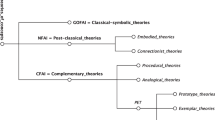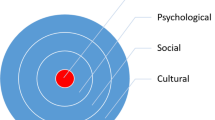Abstract
The paper focuses on two pivotal cognitive functions of both natural and AI agents, namely classification and identification. Inspired from the theory of teleosemantics, itself based on neuroscientific results, we show that these two functions are complementary and rely on distinct forms of knowledge representation. We provide a new perspective on well-known AI techniques by categorising them as either classificational or identificational. Our proposed Teleo-KR architecture provides a high-level framework for combining the two functions within a single AI system. As validation and demonstration on a concrete application, we provide experiments on the large-scale reuse of classificational (ontological) knowledge for the purposes of learning-based schema identification.
This paper was partly supported by the InteropEHRate project, co-funded by the European Union (EU) Horizon 2020 programme under grant number 826106.
Access this chapter
Tax calculation will be finalised at checkout
Purchases are for personal use only
Similar content being viewed by others
References
Baader, F.: The Description Logic Handbook: Theory, Implementation and Applications. Cambridge University Press, Cambridge (2003)
Bader, S., Hitzler, P.: Dimensions of Neural-Symbolic Integration–a Structured Survey. arXiv preprint cs/0511042 (2005)
Barsalou, L.W.: Perceptual symbol systems. Behav. Brain Sci. 22, 577–660 (1999)
Bella, G., et al.: Language and domain aware lightweight ontology matching. J. Web Semant. 43, 1–17 (2017)
Bishop, C.M.: Pattern Recognition and Machine Learning. Springer, New York (2006)
Brachman, R.J., Schmolze, J.G.: An overview of the KL-ONE knowledge representation system. In: Readings in Artificial Intelligence and Databases, pp. 207–230. Morgan Kaufmann, Burlington (1989)
Brickley, D., Miller, L.: FOAF vocabulary specification 0.91 (2010)
Buitelaar, P., Cimiano, P., Magnini, B.: Ontology learning from text: an overview. In: Ontology Learning from Text: Methods, Evaluation and Applications, vol. 123, pp. 3–12 (2005)
Domingos, P.: Structured machine learning: ten problems for the next ten years. In: Proceedings of the Annual International Conference on Inductive Logic Programming (2007)
Euzenat, J., Shvaiko, P.: Ontology Matching, vol. 18. Springer, Heidelberg (2007). https://doi.org/10.1007/978-3-540-49612-0
Evans, G., McDowell, J.: The Varieties of Reference. Clarendon Press (1982)
Gangemi, A., Guarino, N., Masolo, C., Oltramari, A., Schneider, L.: Sweetening ontologies with DOLCE. In: Gómez-Pérez, A., Benjamins, V.R. (eds.) EKAW 2002. LNCS (LNAI), vol. 2473, pp. 166–181. Springer, Heidelberg (2002). https://doi.org/10.1007/3-540-45810-7_18
Getoor, L., Taskar, B.: Introduction to Statistical Relational Learning. MIT Press, Cambridge (2007)
Giunchiglia, F., Fumagalli, M.: Concepts as (recognition) abilities. In: FOIS (2016)
Guarino, N., Welty, C.: Evaluating ontological decisions with OntoClean. Commun. ACM 45(2), 61–65 (2002)
Hinton, G.: Learning multiple layers of representation. Trends Cogn. Sci. 11(10), 428–434 (2007)
da Cunha Lamb, L.: The grand challenges and myths of neural-symbolic computation. In: Dagstuhl Seminar 08041. Recurrent Neural Networks-Models, Capacities, and Applications. Schloss Dagstuhl, Dagstuhl (2008)
Macdonald, G., Papineau, D., et al.: Teleosemantics. Oxford University Press, Oxford (2006)
McNeill, F., Bundy, A.: Dynamic, automatic, first-order ontology repair by diagnosis of failed plan execution. IJSWIS 3(3), 1–35 (2007)
Millikan, R.G.: On Clear and Confused Ideas: An Essay About Substance Concepts. Cambridge University Press, Cambridge (2000)
Millikan, R.G.: Language: A Biological Model. Oxford University Press, Oxford (2005)
Millikan, R.G.: Learning Language. Published in German translation by Alex Burri as ‘Spracherwerb’. Biosemantik. Sprachphilosophische Aufsätze, pp. 85–115. Surkamp, Berlin (2012)
Millikan, R.G.: Beyond Concepts: Unicepts, Language, and Natural Information. Oxford University Press, Oxford (2017)
Muggleton, S., De Raedt, L.: Inductive logic programming: theory and methods. J. Logic Program. 19, 629–679 (1994)
O’Reilly, R.C.: Six principles for biologically based computational models of cortical cognition. Trends Cogn. Sci. 2(11), 455–462 (1998)
Ritze, D., et al.: Linguistic analysis for complex ontology matching. In: CEUR Workshop Proceedings, vol. 689. RWTH (2010)
Rosch, E.: Principles of categorization. In: Concepts: Core Readings, vol. 189 (1999)
Smith, L.B.: Learning to recognize objects. Psychol. Sci. 14(3), 244–250 (2003)
Sarker, M.K., et al.: Explaining Trained Neural Networks with Semantic Web Technologies: First Steps. arXiv preprint. arXiv: 1710.04324 (2017)
Sleeman, J., et al.: Entity type recognition for heterogeneous semantic graphs. AI Mag. 36(1), 75–86 (2015)
Author information
Authors and Affiliations
Corresponding authors
Editor information
Editors and Affiliations
Rights and permissions
Copyright information
© 2019 Springer Nature Switzerland AG
About this paper
Cite this paper
Fumagalli, M., Bella, G., Giunchiglia, F. (2019). Towards Understanding Classification and Identification. In: Nayak, A., Sharma, A. (eds) PRICAI 2019: Trends in Artificial Intelligence. PRICAI 2019. Lecture Notes in Computer Science(), vol 11670. Springer, Cham. https://doi.org/10.1007/978-3-030-29908-8_6
Download citation
DOI: https://doi.org/10.1007/978-3-030-29908-8_6
Published:
Publisher Name: Springer, Cham
Print ISBN: 978-3-030-29907-1
Online ISBN: 978-3-030-29908-8
eBook Packages: Computer ScienceComputer Science (R0)




